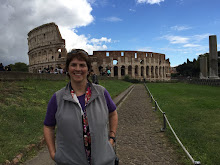I realized as I started reading The Girl Who Drank the Moon that I had read Kelly Barnhill's earlier novel, The Mostly True Story of Jack years ago when it first came out in 2011. I loved that book; it took place in Iowa, and was very unusual and magical. What an imagination Kelly Barnhill has--what a gift!
I picked up this novel because it had just recently won the Newbery Award and I was curious. Whenever I read a teen or young reader novel, I have to constantly check my inner voice and basically tell it to shut up. I have to remember who the intended audience is, and that they are reading from a much more innocent, non-adult place. I think it will do me a lot of good to read more young reader and teen books!
So, to the novel. The Protectorate is a town that is filled with sorrow. It's always gloomy, the sun never shines, and the people live very poorly. The Elders and the Sisters run the show, and they have a yearly tradition that feeds more sorrow into the atmosphere (and keeps people under control): once a year, they take the youngest baby in the village, and leave it in the forest as a sacrifice to the witch that lives there. This keeps the witch from coming to the village and wreaking havoc on everyone. It keeps them safe. This year, a mother fights to keep her child, and is deemed crazy and taken to the Tower, where she is imprisoned by the Sisters. The child is taken to the forest and left there.
Here's the kicker: The Elders have made it all up. They leave the baby in the forest to die from exposure or, worse yet, animals. There's no witch, as far as they're concerned. It's just a way to keep control of the village. Very teen dystopian!
Here's the other kicker: there really is a witch, Xan, who lives in the forest with her friends Glerk, the swamp monster, and Fyrian, the little dragon. She finds the babies every year, and takes them to the other side of the forest, into the towns and villages there, and gives them to loving families. She has no idea why they leave the babies in the forest, but she takes care of them and saves them from certain death. This time, when a baby girl is left, Xan hesitates to take her to the villages for adoption. Feeding her moon magic, she gives the baby too much, and the baby becomes magical. Xan decides to keep the baby for herself, names her Luna, and raises her as her grandmother in the forest. Xan knows when Luna turns thirteen her magic will really kick in, and it will be time for Xan to give all her magic and die. After all, Xan is 500 years old, and ready to be done.
Of course, this plan doesn't work out that well. Luna is a powerful little girl, and the magic is leaking out of her constantly. She has no way to control it, so Xan puts a spell on her that will keep the magic tamped down, and make it impossible for Luna to learn about magic or use it until she's thirteen.
But that's not all that's going on in this story. There's a young man in the village who struggles with the yearly tradition, and seeks a way to reconcile his feelings and find a solution. He's got hope, a tiny spark of hope, that things will change. But the change is not something that the Elders or Sisters want.
I wondered if a child reading this novel would understand the undertone of powerful people doing bad things, and the oppression of people. That the face some people put on in public is not who they really are, and it can hide some bad stuff. That those people you think are bad just by hearing stories or seeing their physical self, actually are very kind and loving people who got a bad rap through stories and gossip. They are the true healers and good people.
I did enjoy this novel; I do wonder at the length for young readers. I'd say advanced readers would swallow it up pretty quickly, but younger kids would struggle a bit. The writing is fantastic, and the plot is pretty clever. You can almost feel the magic oozing off the pages. I enjoyed how the story unfolded and concluded. Worthy of the Newbery. Hope to read more of Kelly Barnhill; if she ever wrote an adult novel I'd grab it without hesitation.
Rating: 4/6 for a beautifully written young reader novel about family, love, magic, sacrifice, and the evil that lurks behind those who are supposed to be looking out for all of us.
Available in hardcover and e-reader.



I usually read the Newbery winner but have not gotten to this one yet. I love the cover! You said, "I wondered if a child reading this novel would understand the undertone of powerful people doing bad things, and the oppression of people. That the face some people put on in public is not who they really are, and it can hide some bad stuff. That those people you think are bad just by hearing stories or seeing their physical self, actually are very kind and loving people who got a bad rap through stories and gossip. They are the true healers and good people." I think many kids do understand at least an inkling of this. I was one of those kids!
ReplyDelete